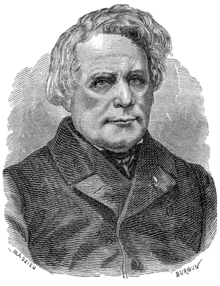Heinrich Daniel Rühmkorff
Heinrich Daniel Rühmkorff (born January 15, 1803 in Hanover , † December 19, 1877 in Paris ) was a Franco-German mechanic and researcher in the field of electrical engineering .
Life
Heinrich Daniel Rühmkorff was born to the postman Friedrich Gottlieb Römkorff and his wife Sophie Kuckuck. His father came from the old Hotteln farming family, the Rühmkorfs, who can be traced back to the early 15th century around Hanover. He spent his apprenticeship years in Hanover, worked in Paris and London and settled in Paris in 1839, whereupon he wrote his name Ruhmkorff (now with "u" instead of "ü"). The pronunciation of his name was preserved because in French a “u” is pronounced like a German “ü”. (The sound pronounced like the German “u” is written in French as “ou”.)
In 1844 he first set up a thermo-electrical apparatus with substantial improvements, and in 1849 an apparatus followed to show the magnetic rotation of the plane of polarization .
Rühmkorff spark inductor
His most famous invention, the induction apparatus (pictures) , was first presented in 1855 at an international industrial exhibition in Paris. With his spark inductor, Rühmkorff succeeded in generating a pulsating voltage of around 100,000 volts from a DC voltage of 15 volts . In 1864 he was therefor by Emperor Napoléon III. awarded the Volta Prize (50,000 francs ) for electrical engineering . In 1867 he achieved powerful popping sparks 40 centimeters long with six Bunsen elements, which caused a tremendous sensation. In the United States, the invention of the spark inductor was claimed by Charles Grafton Page .
Spark inductors were used as voltage generators in the equipment of Heinrich Hertz and Wilhelm Conrad Röntgen , also in Guglielmo Marconi's radio systems and in the Benz patent motor car number 1 developed by Carl Benz . A modern form of his device that is still in use is the ignition coil .
Rühmkorff lamp
Even Jules Verne was inspired by the Rühmkorffschen inductor. In some of his novels a portable light source, the "Rühmkorff lamp" is described (picture) , for example in " The Journey to the Center of the Earth ", which is based on a spark inductor. Such a lamp, described by Jules Verne, was actually made at the time of the book publication by A. Dumas and Dr. Benoit developed and distributed. It was introduced as early as 1862 and can be found as a Miner's Lamp in a few technology museums. However, it was not widespread because it was too expensive and too heavy.
Honors

The Rue Ruhmkorff in Paris and the Rühmkorffstraße in Berlin and Hanover are named after him, as well as that of Eric Walter Elst discovered asteroid (15273) Ruhmkorff .
literature
- Frank Dittmann: Heinrich Daniel Rühmkorff (1803–1877). In: Horst A. Wessel (Ed.): Centuries of high voltage. VDE, 2004, pp. 77-90.
- Karl Ernst Hermann Krause : Rühmkorff, Heinrich Daniel . In: Allgemeine Deutsche Biographie (ADB). Volume 29, Duncker & Humblot, Leipzig 1889, p. 615.
- Anita Kuisle : Rühmkorff (Ruhmkorf), Heinrich Daniel (Henri). In: New German Biography (NDB). Volume 22, Duncker & Humblot, Berlin 2005, ISBN 3-428-11203-2 , p. 221 ( digitized version ).
Web links
- Andreas Fehrmann: Jules Verne and electricity. Chapter 2: The Glorious Korff Lamp
Individual evidence
- ^ RC Post: Stray sparks from the induction coil: The Volta prize and the Page patent. In: Proceedings of the IEEE , 1976 (64), 9, 1279-1286 ( digitized version ).
| personal data | |
|---|---|
| SURNAME | Rühmkorff, Heinrich Daniel |
| BRIEF DESCRIPTION | German mechanic and instrument maker |
| DATE OF BIRTH | January 15, 1803 |
| PLACE OF BIRTH | Hanover |
| DATE OF DEATH | December 19, 1877 |
| Place of death | Paris |



